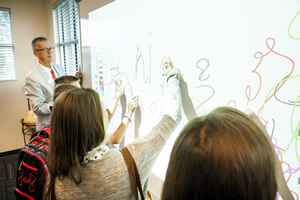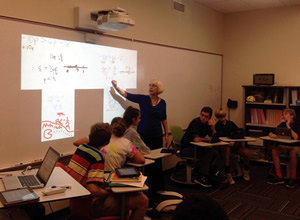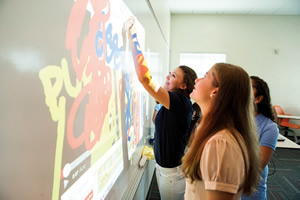Digital Video Schools
- By Michael Fickes
- 03/01/15

PHOTOS COURTESY OF TAMPA PREPARATORY SCHOOL
Video technology is changing the way teachers teach and students learn. Take a look at how two schools are putting video to use. One is a relatively wealthy private school in Tampa, Fla. The other is an average school district in Manteca, Calif. Both have solved the budget problems related to video technology and successfully inserted video into their curricula.
Bring your own device to Tampa Prep
The Tampa Preparatory School in Tampa, Fla., is an independent middle school for grades 6 to 8 and a high school for grades 9 to 12. A bring-your-own-device school, Tampa Prep has been recognized as an Apple Distinguished School for its use of technology. All students bring their own iPads for use in day-to-day classes.
“The students use iPads to create multi-media presentations,” says Chad Lewis, the school’s technology director.
They shoot video with iPads and cut and edit with Apple’s iMovie and Pinnacle Studio software.
“About 90 percent of our books are digital,” continues Lewis.
“Our workflows are digital — students submit assignments digitally and teachers grade digitally.”
Each active-learning classroom boasts two or three Epson BrightLink projectors. “We want every student to have the same auditory and visual experience wherever they might be in the classroom,” Lewis says. “With two or three BrightLinks, teachers can display the same image or two or three different images.”
The iPads are all equipped with an Epson app called iProjection, which enables students and teachers to project images and files through the BrightLink projectors. “Teachers can also drag and drop the names of students into the projector display to call up images or video on their devices,” adds Lewis.
The BrightLinks project images or video onto the walls of the classroom. The teacher and students can annotate the video to highlight key elements. Older BrightLinks came with special light pens that interacted with the light from the projector to write comments. The images, video and annotations could later be saved as a file that the class could access from computers or iPads.
The latest BrightLinks do not need the pens. Students simply use their fingers to write comments.

PHOTOS COURTESY OF TAMPA PREPARATORY SCHOOL
Show and Tell. Patricia Embry, the associate director of middle school and mathematics department chair at Tampa Preparatory School, Tampa, Fla., is pictured using a BrightLink 595Wi with her students. The projector links to the teacher’s and students’ iPads so that either can project images for the class.
“Students are bringing more and more devices into the classroom, and our projectors provide the connectivity to promote and facilitate collaborative learning opportunities through the sharing of student work,” says Jason Meyer, senior product manager, Projectors, Epson America, Inc. “Our new short-throw models combined with easy-to-use connectivity solutions to meet the BYOD needs of teachers and students.”
Tampa Prep’s mathematics teachers have flat screen televisions in their classrooms. Both teachers and students can project work from their iPads to the flat screens.
“In the high school, one statistics and math teacher uses four display screens equipped with SMART Board interactive display overlays,” Lewis says.
The overlays transform the flat screens into interactive devices with touch-screen capabilities.
Video production curriculum
Tampa Prep also offers video production courses beginning in eighth grade with an introductory course. “We cover the fundamentals of making good video,” Lewis says. “Students use iPADs to capture images.”
The video production course also covers green screen shooting. In the green screen process, a student captures the image of a person or object with a green screen forming the background. In postproduction, students learn to composite the green screen image into a full screen video scene. This is done with a compositing software and something called a Chroma Key to eliminate or key out the green background and layer the action from the green screen shot onto the main action of another scene. The App Store even has a Chroma Key App for the iPAD.
The technique is used frequently in all kinds of video productions. One common use for the green screen shoots sports announcers against green screen and composites them over the playing field.
“In ninth grade, the video curriculum moves on to high-end video cameras and video production studios” Lewis says. “We have five new Mac Pros, which are often used in professional video production studios. The course exposes students to Final Cut Pro, a video editing application, and Motion Graphics, which is used to create 3D graphics.”
Tampa Prep teachers use technology virtually every day in most classes. To make sure that teachers can use all of the technology tools to the greatest advantage, the school employs a full-time technology integration specialist to teach the teachers.
“We provide a lot of training,” Lewis says. “We encourage the faculty to go to various websites to read about using technology in the classroom. Our technical integration specialists also visit teachers in the classroom.”
“We’re very pleased with what video brings us,” Lewis concludes. “The ability to use and create multimedia presentations has become a key modern literacy. Students must write well, speak well and, now, create quality multimedia presentations. Business already communicates using multimedia and it will only grow more and more widespread as time goes by.”
One-to-one technology in Manteca
Not all schools and school districts can expect students to bring their own technologies. So when the Manteca Unified School District (MUSD) in Manteca, Calif., created its “Going Digital 2015 Project,” it began by figuring out how to finance an annual technology budget line.
The program stems from the realization of the role that technology is playing and will continue to play in 21st-century life. Given that role, the district decided it had to equip MUSD teachers and students with technology, a decision that will cost the district $30 million per year.
Where will that money come from? “Six years ago, California made huge budget cuts,” says Clara Schmiedt, senior director of curriculum and instruction at MUSD. “We drastically cut our own budget. As we came out of that horrible time and money came back into the budget, our board agreed to reallocate funds to begin the annual $30 million investment in the technology initiative.
“By reallocating, the board took funds from other lines in the budget and created a separate, continuing line item for technology.”
The new line item first addressed infrastructure needs and spent $20 million to install a wireless system for Internet access in all of the district’s schools — 20 elementary schools, five high schools, two alternative high schools and a charter school.
Currently, the district is completing the distribution of devices to students and teachers. “We started deploying devices in January, and we’re almost finished,” Schmiedt says.
When the deployment is finished, all 23,000 students will have a Panasonic 3E two-in-one device with Microsoft software. As you may know, a two-in-one device resembles a laptop computer. It opens up with a screen and keyboard A two-in-one device has a removable screen. It unplugs from the keyboard and becomes a tablet.
Students have three choices for using the device. They can use the keyboard, touch screen or a screen stylus.
The teachers received a Microsoft Surface Pro 2 tablet, which also doubles as a laptop and tablet. Teachers also received a Miracast wireless screen projection device.
“As we deploy the technology, we are making regular site visits,” says Schmiedt. “I visit schools every week, and it is amazing how teachers have already begun using the devices with students.”
Teachers will also receive training in classroom applications of the technology. In its brochure about the “Going Digital 2015, the district says, “As teachers are provided with deeper, more advanced staff development, they should begin to integrate a variety of digital devices into their instruction and into student learning opportunities in a manner that is seamless and natural.”

PHOTOS COURTESY OF TAMPA PREPARATORY SCHOOL
Wall Drawings. Students and teachers use their fingers to write comments on projected images. The images, video and annotations can later be saved as a file that the class could access from computers or iPads.
Additional classroom technology includes an Actiontec ScreenBeam, a wireless connection that teachers and students can use to project material from their devices to the classroom projector.
Like Tampa Prep, MUSD offers a video production course of study and has bought a Panasonic package called Studio in a Box to support those classes.
Currently, a couple of classes are designing and building a system that will stream video of the district’s sporting events over the net.
When completed, the MUSD program will provide digital access to all students in grades K-12 during the instructional day. Students in grades 4 through 12 may be able to take their devices home. That hasn’t been decided yet.
However, the district also plans to facilitate student access to the Internet through their own personal devices and to develop a financially practical program for families to lease or purchase the devices for their children.
Both Tampa Prep and MUSD have tuned in to the technology tools with which students will need to become proficient to live well and work productively in the 21st century. Both have addressed the huge financial challenge posed by equipping entire schools with technology. Each has found a different but effective financing approach.
This article originally appeared in the issue of .